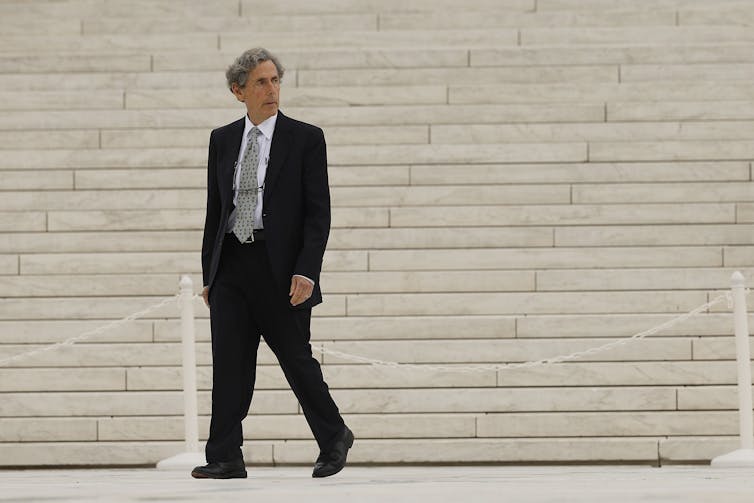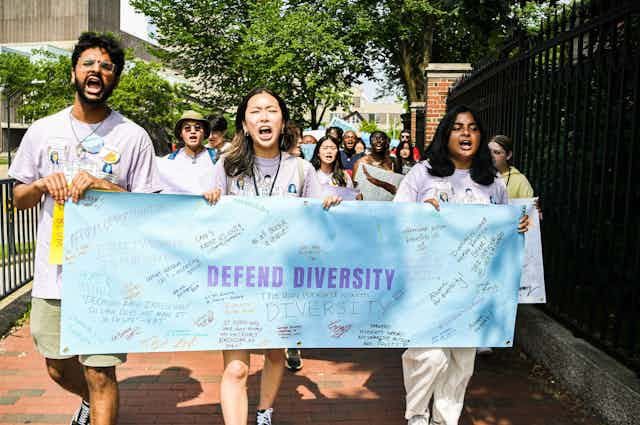In two cases challenging the use of race in college admissions, the U.S. Supreme Court ruled that the educational benefit of racial diversity is no longer what it once called a “compelling interest.”
These decisions effectively end race-conscious college admissions. In my view, as a legal scholar of implicit bias and critical race studies, they do not end discrimination against Asian Americans, which was the advertised goal of the lawsuits.
The cases against Harvard and University of North Carolina at Chapel Hill were both brought by Students For Fair Admission, an organization created by Ed Blum, a California businessman who has successfully challenged many affirmative action and voting rights laws.
In the lawsuits, Blum strategically featured the plight of Asian Americans.
But before he could initiate the lawsuits, he needed people with the standing to sue.
“I needed Asian plaintiffs,” Blum told a group gathered by the Houston Chinese Alliance in 2015.
Why did Blum need Asian Americans? It’s my belief he felt the need because Asian Americans can be depicted as especially sympathetic victims and model minorities cruelly harmed by affirmative action.
It’s not surprising, then, to hear some Asian Americans celebrating the Supreme Court’s decision as striking down discrimination against them.
That’s not what actually happened.
Discrimination against Asian Americans
Are Asian Americans discriminated against in college admissions? That’s a hard question to answer, for two reasons.
First, in order to know what counts as discrimination, a baseline is needed for comparison. In other words, you must ask, “As compared to whom?”
For race discrimination, the natural comparison is with white people because historically that race has received the best treatment. This is why important civil rights statutes, passed after the Civil War, explicitly guarantee the same contracting and property rights “as is enjoyed by white citizens.”
Second, in order to uncover subtle discrimination, analysts often need statistical techniques. Both sides in the litigation used multiple regression, which selects a specific set of predictor variables – such as test scores, grade-point averages and race – and then calculates how much each variable affects the admissions decision controlling for all the others.
The two sides bickered over which variables should be included in the model. Harvard sought to include far more variables. In contrast, Students For Fair Admission wanted fewer.
It turned out that including more variables, such as personal ratings and legacy status, made race less important to the admissions decision.
That’s partly because personal ratings and legacy status are themselves correlated with race, and adding overlapping variables into the model blurs each variable’s unique impact.

In the end, the trial court sided with Harvard’s model, which meant that, in a comparison between an Asian and white applicant with identical test scores, GPAs, personal ratings, legacy status and so forth, the applicant’s race did not matter in the regression.
Thus, the court found no discrimination.
This finding was affirmed on appeal by the 1st Circuit Court of Appeals, and the Supreme Court did not overturn that finding.
In my view, it’s simply erroneous to think that the Supreme Court struck down discrimination against Asian Americans since none was ever found.
Ending affirmative action
Although the lawsuits emphasized the problem of discrimination against Asian Americans, their real target was the use of race in affirmative action programs that benefit underrepresented racial minorities.
Over the past 45 years, the court had cobbled together a compromise on affirmative action in higher education.
On the one hand, explicit race-conscious decision-making must satisfy strict scrutiny under the equal protection clause, with a requirement that it further a “compelling interest” through “narrowly tailored” means. Strict scrutiny is the most rigorous form of judicial review used to determine the constitutionality of certain laws.
On the other hand, in the rarefied domain of higher education, diversity would count as a “compelling interest.”
This diversity rationale was introduced by Justice Lewis Powell in his concurring opinion in Regents of the University of California v. Bakke in 1978.
In his analysis, Powell rejected the justification for affirmative action as a way to remedy centuries of past societal discrimination. He considered that justification “an amorphous concept of injury that may be ageless in its reach into the past.”
Instead, Powell settled on the concept of diversity.
Although no other justice joined Powell’s opinion, it broke the tie and decided the case. It’s this understanding of diversity-as-a-compelling-interest that eventually garnered majority support in Grutter v. Bollinger and Fisher v. University of Texas that allowed the use of race in college admissions to continue.
In 2023’s Students For Fair Admission cases, the Supreme Court tore up this delicate truce that enabled race to be used as a factor in college admissions.

Writing for the majority, Chief Justice John Roberts explained that the educational benefits of diversity were too unmeasurable to be compelling.
Whether the benefit was framed as training future leaders, better educating students through diversity or preparing engaged and productive citizens, Roberts wrote that these interests were “not sufficiently coherent for purposes of strict scrutiny.”
Robert’s opinion effectively ended affirmative action in higher education.
Does nothing to stop discrimination against Asian Americans
The Supreme Court ruling against affirmative action was a happy result for some conservative politicians and horrifying for civil rights advocates.
What’s important is to avoid confusion about the reasons why.
It’s my belief that the end of affirmative action does nothing to end discrimination against Asian Americans as compared to whites.
The reason why Asian Americans are treated worse than whites in college admissions is because huge preferences are given to legacy applicants, who are disproportionately white.
Another reason is that huge preferences are given to athletes in sports that include tennis, lacrosse and fencing. These athletes are also disproportionately white.
Finally, Asian Americans likely suffer some discrimination in personal ratings because of implicit biases.
Recommendations and interviews are highly subjective, based on gut-level enthusiasm and reactions. That means they are vulnerable to implicit biases that frame Asians as mathematically competent but cold, foreign and unlikable.
If Students For Fair Admission’s true objective were to end discrimination against Asian Americans vis-a-vis whites, it would have asked the court to end legacy and athlete preferences and build procedural guardrails against implicit bias. It did not.
Zero-sum game
Of course, the point could be made – as the chief justice did – that “college admissions is a zero-sum game.”
“A benefit provided to some applicants but not to others necessarily advantages the former group at the expense of the latter,” Roberts wrote.
Under this logic, by ending affirmative action, Asian Americans as a group receive some small benefit in admissions chances. But remember that whites receive the exact same benefit. And legacy status, athletic experience and implicit biases will continue to favor whites over Asian Americans.
Finally, is this tiny benefit worth the cost of decreasing the number of Black, Latinx, Native American and underrepresented Asian and Pacific Islander students at elite colleges and universities?
In my view, the answer is no, but that question merits a hard conversation about the policies and principles underlying a racially just society.
I believe that Americans deserve to have that conversation without being misled into thinking that keeping affirmative action is the same thing as tolerating anti-Asian discrimination.

